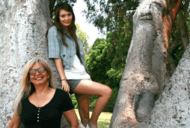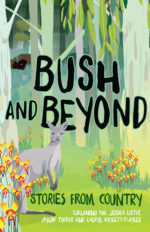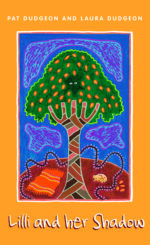INTERVIEW: Pat Dudgeon and Laura Dudgeon authors of Lilli and her Shadow

Where did the inspiration for Shadow come from?
Pat: We thought, if you were a young child who had moved towns and were lonely, wouldn’t it be good to have a secret creature to keep you company and protect you? Shadow is a friendly protective creature who loves Lilli and her mother and nanna. He lives under a special mango tree and can only be glimpsed in Uncle Bernie’s paintings. In a sense, he is passed on from one to the other.
It was fun developing the character of Shadow. We decided that he would be a cross between a dog and cat, jet black with sparkling green eyes and sharp white teeth. We thought about what sorts of magical powers he should have. Initially he didn’t speak much and only by telepathy but later that evolved to just speaking. He can change shape and merge into hard surfaces, so Lilli is able to find him by feeling the surface for his body warmth. This was one of the games they played – a kind of ‘hide and seek’. Another game was Shadow becoming a ‘kite’ as he can make himself into a thin flat shape like a big piece of paper and be either soft or stiff. That is how he is sent home at the end. In one part of the story (which was deleted), Lilli ties string to him and throws him into the wind and he sails in the sky like a kite. He can make himself small as well, so he fits into Lilli’s backpack.
Laura: Shadow was the guardian angel that I wish I had had when I moved away from my nanna. I found it so hard leaving half of my family behind. Although people at my new school were very welcoming and I made new friends fast, not even the best of friends can replace cousins and family that I missed very day, especially at Christmas. Christmas up north was always a really big event with aunties, uncles, cousins, grandmas and grandpas, but down south I only had Mum, Aunty Pat and my brother and two older sisters. It felt so empty and made me feel somewhat alone even though I had friends and a very supportive mother. Also, I am fortunate to have a gorgeous dog named Monty who I love and who is my special friend. Part of Shadow is the cats and dogs we love as well. The magical part.
This is different to some earlier Indigenous literature, in that it features a modern Indigenous family as well as traditional ideas that might be unfamiliar to a lot of Australian kids. How important is it that kids hear these kinds of stories?
Pat: Lilli and Her Shadow reflects contemporary Indigenous life. As everyone knows there is considerable diversity in the lifestyles of our people. Even in our extended family there is diversity. Often an urban reality is not portrayed and this is important – to make sure that all the ranges of Indigenous experiences are presented. When we wrote Lilli and her Shadow we had in mind an Aboriginal community – a bit of Broome, Beagle Bay and Darwin – where we could walk to each other’s houses. The everyday things, such as living in a distinct community with extended family, the local environment and adapting to a different setting, are all important. The differences in children adapting is important too. Lilli is shy and takes some time to settle into her school, whereas Phil has no problems.
Laura: This story reflects on my life in a modern Aboriginal family. All children – Aboriginal and non-Aboriginal can relate to the experiences in the book. It is important for children to see that they have things in common with other cultural groups.
Pat and Laura, you are already family (aunty and niece) – what was the influence of family on this story?
Pat: The importance of family deeply influenced this story. Both of us are away from our hometown and home country (Darwin and Broome). We grew up with family all around us. Family still stay with us when they come down from the north and we try to get home as much as possible. Talking about families was important in the book. Even though Lilli’s parents have chosen to go down south for work, connection to their home and family is strong.
Laura: Yes, I would agree with Aunty Pat; family is very important to Indigenous families and this was one of the key factors we aimed to express in the story. Through my own experience, I know the anxiety caused from loss of family. Children all over experience this through divorce, death or a change such as separation because of work commitments. They all leave the child emotionally torn, like Lilli. We wanted kids to relate to the story as lots of families split for many reasons.
How long did it take to write, and what was the joint writing process like?
Pat: This collaboration has worked very well. Laura has written previously so we were able to work together well. I have mainly written boring academic papers and this was my first children’s book. Having Sally Morgan’s support and in the editorial role was invaluable. Thank you Sally!
The writing process was long. We did lots of work together developing the story line and the characters. Shadow’s character is the most complicated. Much of what we initially wrote about Shadow was left out. Shadow’s character was much more detailed and somewhat darker, but probably a little scary for the age group we were writing for. I was looking at our original notes and they are quite different. The story evolved as we went along.
Laura:: Yes, the book has changed from the original. Originally, it was quite gory! It was fun to write but we thought it might be too violent for the age group. Although the story did take awhile, I enjoyed the time with my Aunty Pat and the brain storming sessions.
Where did the idea for the story as a whole originate?
Laura: As a kid I remember that keeping a secret was a really big deal and it was something special that no-one else has, like Shadow. Also I used to wish I had a secret friend that no one knew about, who would appear when needed and understand all my feelings. It was through my experience of separation from my family and desire for a secret friend that Lilli and her Shadow evolved.
I hope other young people who are going through similar experiences might be helped by this story. Also kids who have new kids come into their school might be understanding and be especially welcoming to the new kids.
Pat: Laura’s experience of moving from the north to a city in the south could be any Aboriginal or non-Aboriginal child’s story. The north and south of Western Australia (or the whole country) is significantly different. There is a totally different lifestyle – the climate, the flora and fauna, the population, Indigenous people being much more visible. Because of the settlement patterns in Australia, north was always seen as the frontier. It is only recently that the north has been part of the Australian identity in a real everyday life way (not the romanticised versions). And it has only been recently that the food and services in northern towns has improved. In my childhood, we did not get the fresh fruit and vegetables that people down south enjoyed. It was all tinned or frozen goods. Local foods such as tropical fruits were common, and exotic to down-south people. There was a great Asian influence up north too so the tasty eats we loved as children (salty plums!) were very scarce down south. However, transport has changed considerably, so Laura’s generation have different experiences. Also a new multiculturalism means that Asian foods are easy to obtain in lots of places nowadays.
Still, there remain great differences between the north and the south. For a young Aboriginal child, moving south means adapting to a very different lifestyle, often without the extended family you take for granted in your own country.









